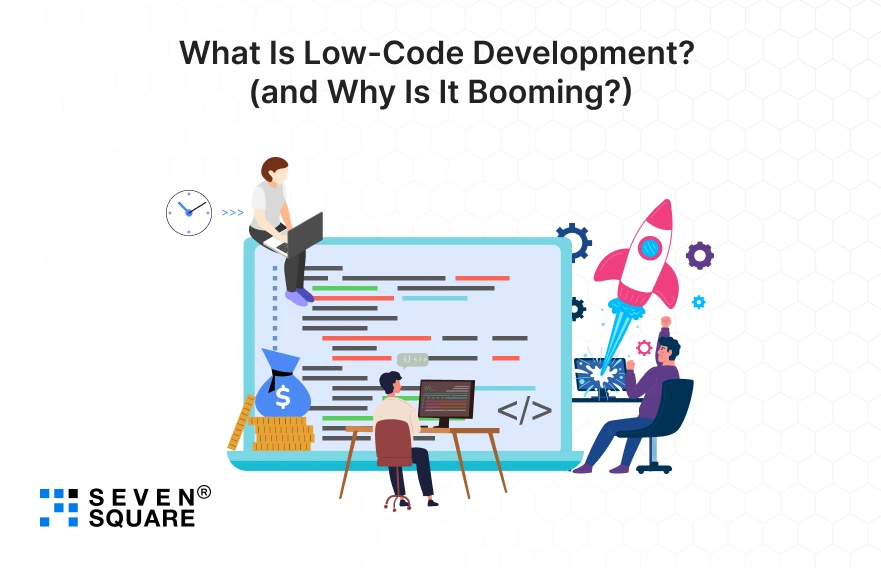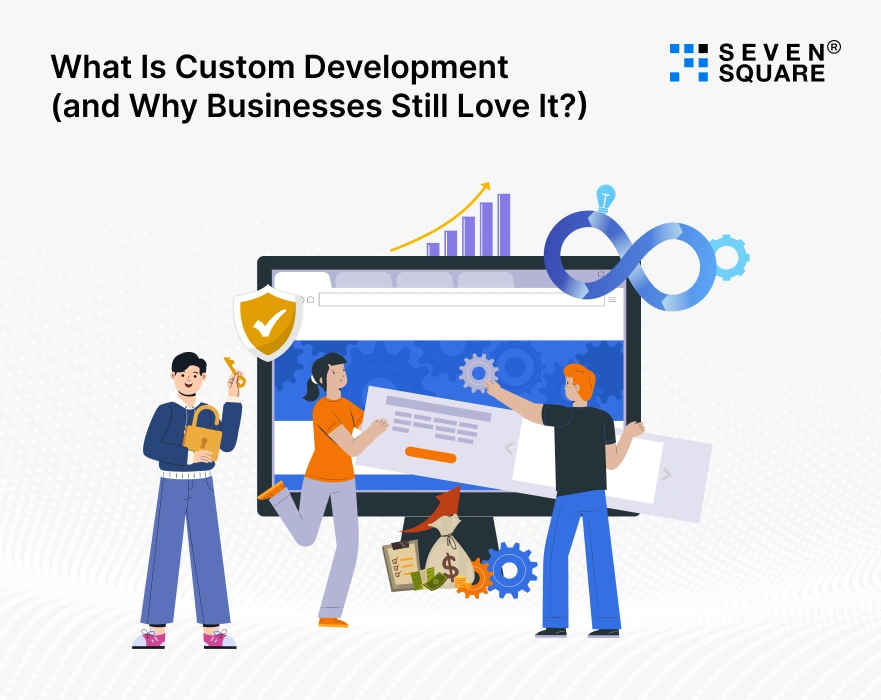Every business today wants to build software faster without compromising its quality. The challenge is real. On one hand, companies need to launch products quickly.
On the other hand, they want reliable, scalable, and secure solutions that last. That’s where the debate of low-code vs custom development begins.
Various businesses are now asking: Should we use a low-code platform for speed, or go with custom development for long-term scalability?
In simple terms:
- Low-code development allows teams to build apps using drag-and-drop interfaces with minimal coding.
- Custom development involves writing code from scratch to create a fully personalized solution.
With rising development costs, AI-based automation, and the race to launch faster MVPs, picking the wrong approach could delay your product’s success.
What Is Low-Code Development? (and Why Is It Booming?)

Low-code development is changing the way businesses build software.
Instead of writing thousands of lines of code, developers (and even non-developers) can create applications using visual, drag-and-drop interfaces.
Popular low-code platforms for enterprises like OutSystems, Mendix, and Microsoft PowerApps make it possible to launch fully functional apps in weeks.
Advantages of Low-Code Development:
- Speed: Build and launch apps 3x faster.
- Cost Efficiency: Lower development costs and minimal maintenance.
- Accessibility: Allows teams without full coding expertise to create solutions.
- Scalability: Many platforms now support enterprise-level deployment.
We’ve helped businesses use low-code to create MVPs, internal dashboards, and customer apps, all in record time.
Because of its faster time to market, low-code development is perfect for:
- Startups that need quick MVP validation.
- Internal business tools for automation.
- Prototypes that evolve into full products later.
In the race of low-code vs traditional development, low-code wins on speed, cost, and flexibility for smaller or medium-scale projects.
But while speed is great, what about full control and scalability? That’s where custom development comes in.
Explore Low-Code vs No-Code Comparison for AI App Development.
What Is Custom Development (and Why Businesses Still Love It?)

Custom development, also known as traditional development, means building an application from the ground up using programming languages, frameworks, and architectures according to your business needs.
While it takes more time and investment, the advantages of custom development are unmatched when it comes to control, scalability, and security.
Key Advantages:
- Unlimited Flexibility: Every feature can be designed exactly the way your business needs it.
- High Scalability: Easily handle growing users, data, and integrations.
- Strong Security: You control how data is stored, accessed, and protected.
- Long-Term ROI: A well-built custom solution pays off over time.
Our team specializes in helping businesses scale their systems with robust custom development.
We’ve seen large enterprises and startups alike choose this route when they need deep integrations, complex workflows, or industry-specific compliance.
Ideal For:
- Enterprise systems with complex architecture.
- Fintech or healthcare apps need compliance.
- Industry-specific platforms that demand unique workflows.
In short, custom development may take longer, but it’s the smarter choice when your business needs performance, scalability, and long-term growth.
Low-Code vs. Custom Development: Key Differences You Must Know
Choosing between low-code and custom development is a strategic one. Every business wants a solution that fits its needs, budget, and growth plan.
We often help businesses through this low-code vs custom software development dilemma. Both approaches work, but in very different ways.
Let’s explore their key differences so you can make an informed choice.
Low-Code vs Custom Development Comparison Table
| Feature | Low-Code | Custom Development |
| Cost | Lower upfront cost & ideal for businesses with limited budgets or MVP launches. | Higher upfront cost & more investment at the start. But the long-term ROI is higher because you fully own your solution. |
| Speed | Faster, build and deploy apps within weeks using drag-and-drop tools. | Slower but precise, it requires more time for coding, testing, and deployment, but delivers a highly stable and scalable product. |
| Flexibility | Limited & you work within the platform’s boundaries. Some advanced customizations may not be possible. | Fully customizable, as every feature, integration, and workflow can be designed exactly the way your business operates. |
| Scalability | Moderate is good for small to medium-sized projects, but can hit limitations as your user base or features grow. | High which is built to handle complex logic, integrations, and large-scale user traffic without performance issues. |
| Security | Depends on the platform as you rely on the platform’s built-in security and compliance standards. | Fully controlled & You decide how data is stored, encrypted, and protected. Best for industries with strict compliance needs. |
The real difference between low-code and custom software development comes down to control, scalability, and long-term goals.
- If your priority is speed and cost-efficiency, low-code development is an amazing choice, especially for startups or internal business tools.
- But if you’re aiming for growth, enterprise-level performance, and full flexibility, custom development wins every time.
That’s why we often recommend a balanced approach, start with low-code for your MVP & then scale it up with custom development once your product matures.
Time, Cost & Scalability: Which Approach Delivers Better ROI?
When it comes to software development, time and cost often make or break a project. That’s where understanding the low-code vs custom cost comparison becomes important.
We’ve seen both sides: Companies that launched lightning-fast MVPs with low-code and enterprises that invested in custom builds for long-term growth.
Here’s the simple truth:
- Low-code platforms offer a faster time to market. You can often build a working MVP in just 2 to 3 weeks.
- Custom development, on the other hand, might take 8 to 10 weeks, but it delivers better scalability and control.
When comparing ROI in low-code vs custom development, the answer is clear:
- Low-code gives quick returns for short-term goals (MVPs, internal tools, prototypes).
- Custom delivers sustained ROI through ownership, performance, and future-proof scalability.
When to Choose Low-Code vs. Custom Development?
Choosing between low-code and custom development doesn’t have to be confusing.
It’s about matching your business goals, timeline, and resources with the right technology.
Here’s a practical guide from us to help you decide:
Choose Low-Code When:
- You’re building an MVP or testing a new product idea.
- You need to launch in weeks.
- You have limited development resources or budget.
- You need a simple app or internal tool quickly.
- You want to reduce initial investment and validate your idea fast.
Choose Custom Development When:
- You need complete control over features and performance.
- You’re building for long-term growth and scalability.
- Security and compliance are top priorities.
- You require custom integrations or unique workflows.
- You’re creating a core business application.
Why Do Businesses Trust Us for Scalable Development?
Whether you need low-code development services for faster delivery or custom software development for enterprise-grade scalability, we’ve got you covered.
We specialize in building flexible, future-ready solutions for your business.
Our Approach
Analysis → Architecture → Implementation → Scale
From idea validation to long-term maintenance, we support you at every stage.
- Experts in FlutterFlow, OutSystems, Mendix, and React full-stack builds.
- Proven success in enterprise-level deployments.
- Smooth scaling from MVP to full-fledged applications.
- Secure, efficient, and performance-driven systems.
Want a Low-Code or Custom Solution? Contact Us Today!
Your Business, Your Choice: But Make It Informed
There’s no one-size-fits-all when it comes to low-code vs custom development. The best approach depends on your goals, budget, timeline, and scalability needs.
- Choose low-code if speed, simplicity, and cost matter most.
- Choose custom development if you need power, flexibility, and long-term growth.
- Combine both through a hybrid approach for balanced results.
FAQs
- If you’re testing an idea or building an MVP, start with low-code for speed and lower cost.
- Once you validate your product, shift to custom development for better control and scalability.
- Yes, modern low-code platforms for enterprise, like OutSystems and Mendix, support large-scale apps.
- But for highly complex or integrated systems, custom development remains the better option.
- Low-code works well for moderate user loads, but if your app needs to scale to millions of users, you’ll eventually need custom development for optimized performance.
- Custom development provides better security control, as everything is built and managed in-house.
- Low-code depends on the platform’s built-in security and compliance features.